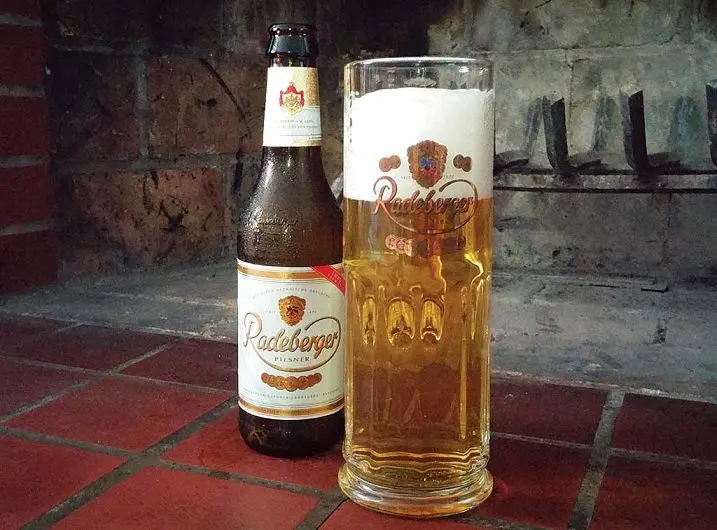Radeberger Pilsner is one of the ten most popular beer brands in Germany. The plant in Radeberg annually produces 2 million hectoliters of the drink. It is exported all over the world. It is noteworthy that the plant produces only one type of beer, the taste of which has not changed for 140 years. Nevertheless, the fashion for this pilsner does not go away. Beer fully justifies its advertising motto: “Radeberger Pilsner – always special.”
Historical reference. In the second half of the XNUMXth century, it suddenly became clear that many Saxons consider the Czech pilsner to be the best of all types of beer. Given that he is a direct relative of the Bavarian lager, then for proud Saxon patriots this was a direct insult.
One day, five representatives of the high society of the city of Radeberg gathered in the Knobloch’schen wine shop and, over a glass of pilsner, came to the conclusion that it was no longer possible to live like this. The mayor of the city, the city treasurer, the landowner, the deputy of the Reichstag and the owner of the weaving factory did not like to chat in vain. The friends decided to establish a joint-stock company for the production of the Saxon pilsner.
The eldest of the partners was the landowner Gustav Philipp, who invested all his fortune in the brewery. He became the first director of the plant, which opened in 1872. Herr Philipp approached the matter with truly German thoroughness. The plan was simple: first brew a beer that was identical to a Czech pilsner and then surpass it.
Old brewers say that a lot of the taste of a classic pilsner is due to the water from the Pilsen springs? Let’s get water! And now the son of Herr Philipp is sent with the task of bringing 2500 liters of water from the Pilsen springs on horse-drawn carts.
But while Walter Philipp was overcoming the difficulties of the road, it turned out that in Karlswald, just 7 km from the plant, there is a source of water comparable in softness and taste to Pilsen. A pipeline was immediately laid in Karlswald.
The Radeberg Pilsner turned out to be of such high quality that it soon began to be exported abroad. In 1885, when it was necessary to enter the brewery in the commercial register, it was named Radeberger Exportbierbrauerei.
After the death of Herr Philipp, which happened in 1897, he was replaced as director by his deputy, Konrad Bruhn, who was destined to write the most glorious pages in the history of Radeberger.
Prince Otto von Bismarck himself became addicted to the Saxon pilsner, jokingly calling the drink “chancellor’s beer.” In 1905, Herr Bruhn managed to become the official supplier of the royal court of Saxony, and two years later the king personally visited the brewery. Since then, the Radeberger label has read: “Drink of His Majesty King Friedrich August III of Saxony.”
In the end, the success of the Saxons drew the attention of Czech brewers and went to court demanding a ban on the use of the name “Pilsner” outside of Pilsen. But in 1910, a Saxon court ruled that if the label of a Saxon pilsner says: Radeberger, then no one will confuse these two beers.
Under the direction of Herr Brun:
- the most efficient malt kiln at that time was created;
- a method has been developed for using the residues accumulated in malt shops. Previously, such residues were considered waste and thrown away.
By 1914, the company was producing 230 hectoliters per year. But with the outbreak of the First World War, the brewery was closed, as all the workers went to the front. After the war, Konrad Bruhn set up a fund to help the disabled and the families of fallen servicemen.
After World War II, Radeberger was nationalized and became the largest beer producer in the GDR. After the reunification of Germany, the company was acquired by the Binding-Gruppe from Frankfurt am Main. The plant was equipped with new equipment, thanks to which the production volume increased significantly. In the XNUMXst century, the name Binding-Gruppe was changed to Radeberger Gruppe.
Traditions are sacredly kept at the plant. Every tourist visiting the brewery is sure to be offered a glass of Karlswald water. And the social building built for the workers of the plant was named after Konrad Bruhn.
Features of Radeberger beer
Radeberger Pilsner is a light, bottom-fermented beer. A drink of bright golden color forms a snow-white foam cap. Pilsner has a refreshing, balanced taste, in which the initial notes of malt sweetness are replaced by hop bitterness with fruity undertones. The aftertaste is herbaceous-citrus, with a slight smoky tint. Fortress – 4,8%, density – 10%.










